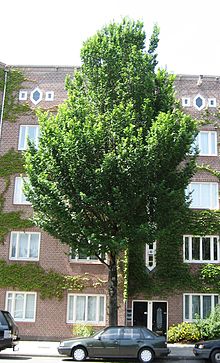Ulmus 'Clusius' is a Dutch hybrid elm cultivar raised at the Dorschkamp Research Institute for Forestry & Landscape Planning, Wageningen, as clone 568[1] and released to commerce in 1983. 'Clusius' was derived from a crossing of the same Dutch clones that produced the fastigiate 'Lobel' released in 1973: '202' ('Exoniensis' × U. wallichiana) and '336' ('Bea Schwarz' selfed).
| Ulmus 'Clusius' | |
|---|---|
 Ulmus 'Clusius', Netherlands. | |
| Genus | Ulmus |
| Hybrid parentage | ('Exoniensis' × U. wallichiana) × 'Bea Schwarz' selfed |
| Cultivar | 'Clusius' |
| Origin | Wageningen, The Netherlands |
Description
editThe tree has a broader crown than its sibling's, whilst the generally obovate leaves, < 11 cm long by 7 cm wide, are less acuminate at the apex and a lighter green. The seed is near the notch (apex) of the samara.[1][2] Like 'Lobel', the tree flushes markedly later than most other elms, and is rarely in full leaf before mid-May.
Pests and diseases
editWhilst the resistance of 'Clusius' to Dutch elm disease proved marginally greater than that of its Dutch predecessors, rated 4 out of 5,[3] it has been eclipsed by later developments such as Lutèce. Consequently, sales in the Netherlands declined from over 8,000 in 1979 to 600 in 2004.[4]
Cultivation
editWhile 'Clusius' remains for sale in Europe, its planting where the disease remains prevalent cannot be recommended.[5] In the UK, 'Clusius' is present in the National Elm Collection, Brighton and Hove,[6] and in Edinburgh (two in Abbeyhill, opposite Holyrood Palace,[7] and one in The Meadows[8]). Six specimens were planted in front of the library, Keele University, Staffordshire, c.2010.[9][10] 'Clusius' featured in New Zealand government trials during the 1990s at the Hortresearch station, Palmerston North, but is not known to have been introduced to North America.
-
Six 'Clusius' in Union Square, Keele University (2015)
-
Same, 2018
Etymology
editThe cultivar is named for Carolus Clusius, a Dutch naturalist of the Renaissance.
Accessions
edit- Europe
- Arboretum de La Petite Loiterie [1], Monthodon, France. No details available
- Grange Farm Arboretum, Sutton St James, Spalding, Lincs., UK. Acc. no. 817.
- Sir Harold Hillier Gardens, Ampfield, Romsey, Hampshire, UK. Acc. no: 2019.0441
- Wijdemeren City Council, Netherlands. Elm Collection. planted mainly in Kortenhoef since 2006.
Nurseries
edit- Noordplant [2], Glimmen, Netherlands.
- Barcham Trees PLC, Ely, Cambridgeshire. [3][4]
References
edit- ^ a b Heybroek, Hans M. (1983). Burdekin, D.A. (ed.). "Resistant elms for Europe" (PDF). Forestry Commission Bulletin (Research on Dutch Elm Disease in Europe) (60). London: HMSO: 108–113.
- ^ Heybroek, H.M. (1993). "The Dutch Elm Breeding Program". In Sticklen, Mariam B.; Sherald, James L. (eds.). Dutch Elm Disease Research. New York, USA: Springer-Verlag. pp. 16–25. ISBN 978-1-4615-6874-2. Retrieved 26 October 2017.
- ^ Heybroek, H. M., Goudzwaard, L, Kaljee, H. (2009). Iep of olm, karakterboom van de Lage Landen (:Elm, a tree with character of the Low Countries). KNNV, Uitgeverij. ISBN 978-90-5011-281-9
- ^ Hiemstra, J.A.; et al. (2007). Belang en toekomst van de iep in Nederland [Importance and future of the elm in the Netherlands]. Wageningen, Netherlands: Praktijkonderzoek Plant & Omgeving B.V. Retrieved 26 October 2017.
- ^ Burdekin, D.A.; Rushforth, K.D. (November 1996). "Elms resistant to Dutch elm disease" (PDF). Arboriculture Research Note. 2/96. Revised by J.F. Webber. Alice Holt Lodge, Farnham: Arboricultural Advisory & Information Service: 1–9. ISSN 1362-5128. Retrieved 26 October 2017.
- ^ List of plants in the elm collection, Brighton and Hove; brighton-hove.gov.uk
- ^ Two 'Clusius', Abbeyhill, Edinburgh - Google Maps, December 2019, access date: 25 July 2024
- ^ 'Clusius', Melville Drive, The Meadows, Edinburgh - Google Maps, August 2020, access date: 29 July 2024
- ^ 'New Trees in Union Square', keele.ac.uk
- ^ 'Clusius' between library and Union Square, Keele University, Staffordshire